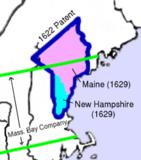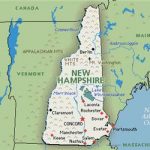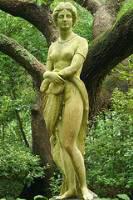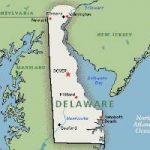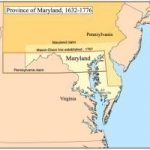History of Maine
Image: Map of Early Maine
The 1622 grant of the Province of Maine is outlined in blue. The Province of New Hampshire is shown in teal, and the colony of Maine is shown in pink. The boundaries of the Massachusetts Bay Company grant are shown in green.
The Province of Maine refers to several English colonies of that name that existed in the 17th century along the northeast coast of North America, roughly encompassing portions of the present-day states of Maine, New Hampshire, Vermont, and the Canadian province of Quebec. The province existed through a series of land patents in several incarnations, the last of which was eventually absorbed into the Province of Massachusetts Bay.
Maine History Timeline
1600
The first English and Acadian settlements in Maine. By 1620, both fishing and trading are well established.
1607
A few months after the Jamestown Colony was established, two ships carrying 125 people arrive at Popham Beach—at what is now Phippsburg. George Popham and Raleigh Gilbert establish an English settlement, known as Popham Colony, at the mouth of the Kennebec River—a fortified village, a dozen cabins, a storehouse, chapel, and a modest sailing vessel, the Virginia.
1608
George Popham dies. Raleigh Gilbert, the new leader of the colony, learns that he has inherited his family’s estates in England, and decides to leave. The colonists elect to return to England in the fall of 1608, and the fledgling Popham Colony is abandoned.
1616-1619
The Great Dying, a three-year pandemic, begins to decimate the Native American population, wiping out some coastal groups altogether. This was just the first of several epidemics that killed as many as 90% of Maine Indians in an area from Penobscot Bay to Cape Cod.
1621
King James I signs a charter that grants most of the land that is Maine today to the Council for New England, a group of English noblemen who plan to settle the area.
1622
The first patent establishing the Province of Maine—the first time the name appears in writing—is granted on August 10, 1622 to Ferdinando Gorges and John Mason by the Plymouth Council for New England. This first patent encompasses the coast between the Merrimack and Kennebec rivers, as well as an irregular parcel of land between the headwaters of the two rivers.
1629
The Laconia Company is formed in England in 1629. The two proprietors of Laconia—Ferdinando Gorges and John Mason—divide their possessions, Mason receiving the portion that became New Hampshire, and Gorges the eastern portion, which was called Maine. The Laconia patent was simply a grant of land from the Council for New England and not a royal charter.
1636
Gorges leased to George Cleeve and Richard Tucker “a neck of land called Machegonne, now Portland.
1639
The royal charter of the Province of Maine to Sir Ferdinando Gorges by Charles II, designed to confirm the allotment made to Gorges in the division of the Patent for New England, was granted in 1639. During the decade and more that followed, affairs were in a disturbed state in the province because of the conflict between the King and Parliament.
1642
Georgeana (York) Maine becomes the first incorporated American city.
1649
Thomas Gorges and others form an independent Province of Maine to protect their land claims and bring some sense of order to the area.
1651
The Province of Maine attempts to obtain official recognition from the English Parliament. The Massachusetts Bay Colony wants to control Maine’s valuable land, and they prevent official recognition of the Province of Maine from taking place.
1652
Maine settlements are scattered in a ribbon-like pattern all along the winding, rocky coast, making it hard to unify them into a single community. Massachusetts Bay Colony annexes southwestern Maine. Massachusetts officials consider it the first line of defense against potential French and Indian invasions.
1664
What had been the Province of Maine is given a grant by Charles II of England to James, Duke of York. Under the terms of this patent, the territory is incorporated into Cornwall County, part of the Province of New York. Unlike the previous two patents, the territory stipulated in the 1664 charter encompasses the areas north of the Kennebec River to the St. Croix River. This region, previously called the Territory of Sagadahock, forms the eastern portion of the present day state of Maine.
1677
In 1677, Ferdinando Gorges’ heirs sell their rights to Massachusetts for $6,000. The territory is then called the District of Maine, and it is governed by Massachusetts until 1820, when it is admitted into the Union as a state.
SOURCES
Maine’s Lost Colony
Wikipedia: Maine History
Wikipedia: Province of Maine
